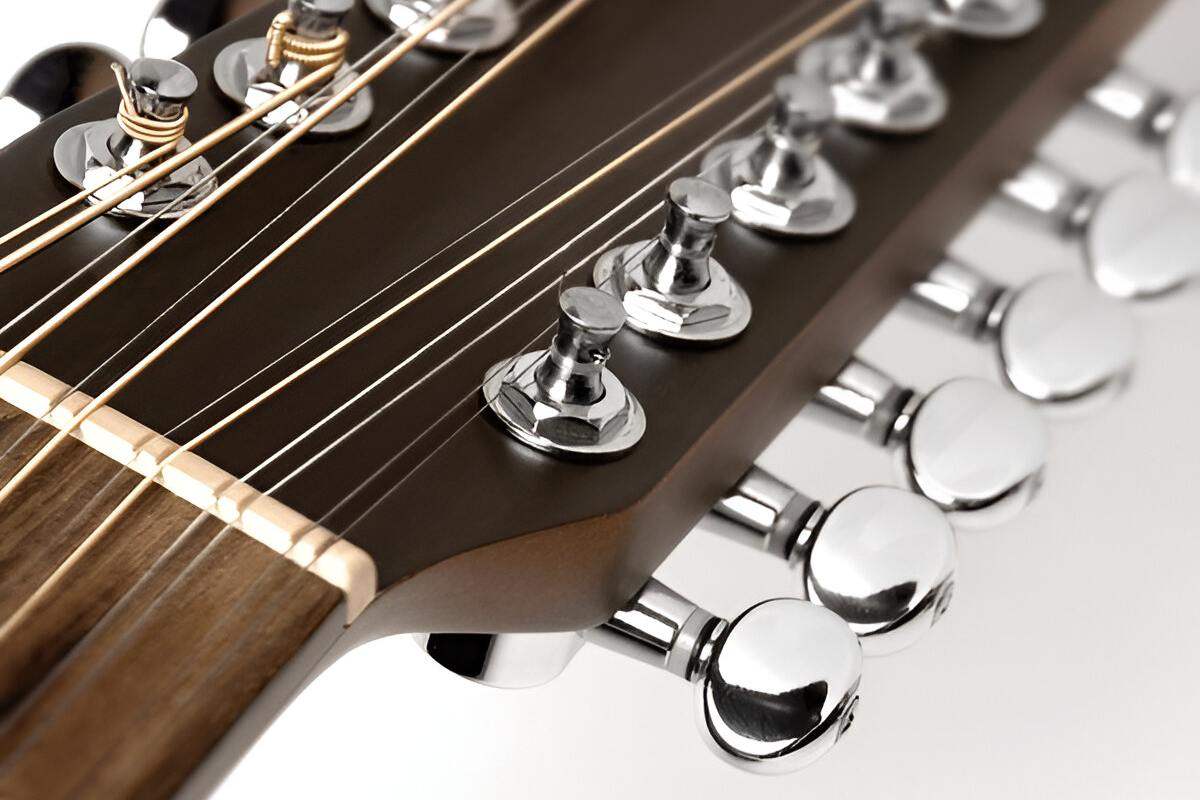12 String guitars are wonderful instruments that are well worth investing in and mastering. However, lots of guitarists aren’t convinced that they’ll get enough use out of them to justify the purchase.
So, I’ve decided to take a closer look at 12 string guitars, both electric and acoustic, and answer all your questions which could well lead to you adding one to your collection. Let’s get started with the absolute basics…
What is the difference between a 12 String Guitar and a 6 String Guitar?
In incredibly simple terms, a 12-string guitar has 12 strings as opposed to the six usually found on a standard guitar. This makes people think that they are difficult to play, you only have four fingers and a thumb after all!
Well, they are a little bit harder to play, but not much. The strings are split into six sets of two and you use the same finger to play both of them. Therefore, there is a little more string tension and you have to be slightly more accurate with your finger positioning, but most reasonable players will get the hang of playing one in no time at all.
Both of the strings within each set of two are tuned to the same note, but for the four lower strings the notes are tuned an octave apart. This gives the guitar a wonderful chorus-like sound because they are understandably often ever so slightly out of tune.

12-string Tuning
In terms of construction, there are some differences that accommodate the 12 strings, such as a larger headstock, a nut with 12 slots, and a bridge and tailpiece that can hold the additional strings.
Apart from that, they are exactly the same as a standard electric or acoustic guitar.
The Best 12-string Songs to Learn
Stairway to Heaven - Led Zeppelin
This has to be the most famous 12-string song ever with most people picturing Jimmy Page on stage with his double-necked Gibson EDS-1275. However, he didn’t use it in the studio, the song was recorded using a 12-string Fender Electric XII and a 6-string Harmony Sovereign H1260 Acoustic.
Space Oddity - David Bowie
From one absolute classic to another. Bowie plays a Hagstrom 12-string acoustic throughout the recording, but it’s also worth checking out the demo version which has the 12-string much higher in the mix so that you can hear what it adds to the song. Would it have sounded the same without the 12-string? Not a chance!
Wish You Were Here - Pink Floyd
The classics keep coming… The first time you play this legendary song on a 12-string, you will never want to play it on a standard guitar ever again. It sounds so good that you just want to keep on playing it for days. Try it, it’s infectious.
Hotel California - The Eagles
By now, you might be thinking that it’s easier to find a legendary song that features a 12-string than one that doesn’t. That isn’t quite the case, but it often comes as quite a shock to anyone who is unfamiliar with the sound of a 12-string guitar, how often they are used. Hotel California is another great example, so get your capo, put it on a 12-string, and enjoy the song the way it should be played.
Mamma, I’m Coming Home - Ozzy Osbourne
One of Ozzy Osbournes classic songs also relies on the sound of a 12-string for its iconic intro. If you’re new to 12-string, this is a great one to play because you are only using one finger moving down the G string with open notes on the B and high e strings for most of the intro.
It’s simple but ever so effective and perfectly highlights the magic a 12-string adds to a song.
Wanted Dead or Alive - Bon Jovi
The main guitar figure uses a similar concept to Mama, I’m Coming Home, but instead of only changing a single note, this time a chord is suggested by every change with the open B strings ringing throughout. It’s a fantastic song to learn and incredibly enjoyable to play on any 12-string, so don’t worry, you won’t need to re-mortgage the house to buy the double-necked Ovation Ritchie Sambora uses in the video.
Love Me To Death - The Mission
I’ll finish with a song that is so distinctly 12-string that it would have sounded completely different if it hadn’t been recorded using one. It creates a magical, mystical, dreamy sound that works perfectly for the song. There is also a lot of chorus added making it even more distinctive.
It was written by The Mission, a band that formed from the split of the Sisters of Mercy. The 12-string is more than likely a Vox Teardrop 12 electric, guitarist Wayne Hussey’s 12-string of choice at the time, but there is also an Ovation Custom Balladeer acoustic 12-string lower in the mix.
The band’s songs feature a lot of 12-string guitar parts and they also use them live for a large number of songs. If you want to hear how a 12-string electric can really make a song, check out The Mission.
Honorable mentions
With so many great songs featuring 12-string guitars, I could go on for days, but keeping it short, here are some of my favorites:
- The Byrds - Eight Miles High, Mr. Tambourine Man, Turn! Turn! Turn!, etc., etc.
- Led Zeppelin - Over the Hills and Far Away
- Stevie Ray Vaughan - Rude Mood
- The Beatles - Ticket to Ride, A Hard Day’s Night
- Tom Petty - Free Fallin
- Boston - More Than a Feeling
- The Rolling Stones - As Tears Go By
- Rod Stewart - Maggie May
- The Who - Substitute
- Jimi Hendrix - Hear My Train a-Comin
- Red Hot Chili Peppers - Breaking the Girl
- Bob Dylan - Hurricane
- America - A Horse With No Name
The Wonders of 12-String Guitars When Recording
If you enjoy layering guitar parts while recording a 12-string is a must have. They can be placed low in the mix to add weight and sheen to a standard guitar part. Or, if you want them front and center, use them to create a much more interesting sound than you get from a standard guitar.
These techniques work with either electric or acoustic 12-strings, or better still… both!

A Fender Electric XII
Converting a 6-string to a 12-string guitar
Many years ago, when money was tight and buying a 12-string electric was out of the question, I asked my luthier if he could convert an old Washburn semi-acoustic I had lying about gathering dust into a 12-string. He said, no problem and got to work. He extended the headstock and added six more tuning machines, changed the bridge and the tailpiece, and the job was done. I can’t remember how much he charged for the work, but it was a lot less than buying a second-hand 12-string.
It sounded great and we used the guitar for recording and occasionally live for many years afterwards. So, if you like to modify your guitars and have always wanted a 12-string, go for it, it’s the cheapest way to join the 12-string Guitar Appreciation Society!
If the thought of extending the headstock is a little frightening, you could always just buy a 12-string neck, a very easy option if you are modifying a Strat, Tele, or anything else with a bolt-on neck. And one more word of advice… go for lightweight tuners, the extra weight of 12 of them as opposed to the usual six can make the guitar prone to neck diving. These Guyker GK-44SP 3R3L Locking String Vintage Deluxe Tuning Pegs at only 32.3 grams each are a great choice.
Wrapping it Up
That’s it for my look at everything you ever wanted to know about 12-string guitars. Now that you see the benefits of owning one, you might be ready to take the plunge and get yourself one of these beauties. It will get a lot more use than you imagine and put a smile on your face every time you play it.
So, don’t delay, join the ever-expanding group of musicians who proudly call themselves a 12-string guitarist today.
If you like this article, please share it!
Be sure to join our FB Group Guyker Guitar Parts VIP Group to share your ideas! You can also have connections with like-minded guitar players, Guyker updates as well as discounts information from our FB Group.









Share:
7 Easy Christmas Songs on Guitar for Christmas Vibe
Top 10 Habits for Proper Guitar Care and Maintenance